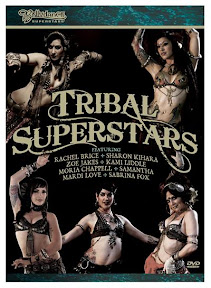
not as described | 2 out of 5 stars
Available via: Bellydance Superstars Shop, Amazon
The BDSS website describes this as a "best of" collection, however what isn't made clear is that the content of this DVD consists only of what Copeland and Co. might consider to be the "best of" what they have previously included on their own releases. There is no new performance material included here, instead this DVD is a compilation of various Tribal style pieces spanning from the very first Bellydance Superstars to the latest Bellydance Superstars: 3D Volume 2. If you have seen or happen to own a number of BDSS DVDs, chances are you will already be familiar with all of the performances on Tribal Superstars:
- Rachel Brice, "Saraab" from Bellydance Superstars
- Zoe Jakes & Issam Houshan drum solo, Bellydance Superstars: 3D Volume 2
- Sharon Kihara, "Bear Hides and Buffalo/Proper Hoodidge" from Tribal Fusions
- Kami Liddle & Sabrina, "Inars" from Tribal Fusions
- Fat Chance Bellydance, "Tin Tin" from Tribal LA: Live in Los Angeles
- Elizabeth Strong, "Romski Cocek" from Tribal LA: Live in Los Angeles
- Mardi Love, "Whiskey Sunrise" from Tribal Fusions
- Tribal Superstars, "The Dude" from The Art of Bellydance: Live from Shanghai
- Samantha, "Wayward Farewell" from The Art of Bellydance: Live from Shanghai
- Tribal Superstars, "Saiidi" from Bellydance Superstars: Live in Paris at the Folies Bergere
- Zoe Jakes & Elizabeth Strong, "Dope Crunk" from Tribal LA: Live in Los Angeles
- Kami Liddle, "A Necessary End" from Tribal Fusions: Volume 2
- Moria Chappell, "Engrish Bwudd" from Tribal Fusions: Volume 2
- Urban Tribal, "Derivations" from Tribal Fusions: Volume 2
This is classic Rachel in all her dark, snakey glory. Unfortunately the camera work is classic to the original Bellydance Superstars DVD meaning that the angles may include prop items from the set partially obscuring the dancer, and shots are often cropped to exclude a significant part of her body.
This was when the Tribal Superstars included Rachel Brice, Mardi Love, and Sharon Kihara. The other group piece included on this DVD is the newer incarnation of the troupe with Kami Liddle, Samantha, Sabrina, and Moria Chappell.
Note: The music is cited as "Saltillo" by A Necessary End but in fact the song title and artist are reversed. I discovered this when I went to search for the song on iTunes.
Note: The credits claim the music as "Ping Heng/Sleeping Somber" by Solace but this is definitely not the case.
Although this is from a newer release in the BDSS catalog, this particular recording also seems to suffer from a lot of periodic cropping which is especially egregious in this case since Urban Tribal rely so much on the overall composition and interaction of their troupe. You cannot appreciate this when forcibly focused on just the upper body of one dancer.
The only worthwhile, new material included on this release are several interviews with various Tribal dancers and Miles Copeland. These are substantial interviews too, not just a few stolen, hectic moments before a show in the dressing room — this section rivals (or exceeds) the length of the performance portion of the DVD. The dancers describe their influences, the challenges of being in an internationally touring bellydance troupe, and some of their experiences from the road among other things. I particularly enjoyed hearing Carolena Nericcio talk about how she came up with the cue system for ATS dance. Almost all of the Tribal Superstars discuss the fact that unlike their Cabaret comrades who have a plethora of bellydance fashion designers from whom to commission costumes for each show, the Tribal Superstars craft their own costumes and are responsible for their own extensive hair and makeup. Moria actually displays the belt and bra is is working on to coordinate with the color scheme of the other Superstars and tells the story behind some of the components. It was also interesting to see most of the dancers without stage makeup (Zoe, Kami, and Sabrina seemed to be only wearing very light makeup. Moria was interviewed still in her stage makeup and elaborately-done hair). The contrast is striking and it allows for a better realization of all the time that must go into preparing for a show.



